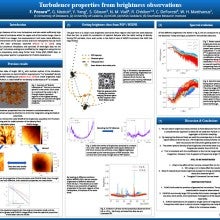Attempt at obtaining turbulence spectral information from Parker Solar Probe waiting for PUNCH
Francesco
Pecora
University of Delaware
Giuseppe Nisticò, University of Calabria
Yan Yang, University of Delaware
Rohit Chhiber, NASA Goddard, University of Delaware
Sarah Gibson, NCAR
Nicholeen Viall-Kepko, NASA Goddard
Craig De Forest, SWRI
William Matthaeus, University of Delaware
Yan Yang, University of Delaware
Rohit Chhiber, NASA Goddard, University of Delaware
Sarah Gibson, NCAR
Nicholeen Viall-Kepko, NASA Goddard
Craig De Forest, SWRI
William Matthaeus, University of Delaware
Poster
Understanding the evolution of turbulence fluctuations in the solar wind from the Sun into the inner heliosphere is a core science objective of the PUNCH mission.
To prepare for PUNCH data analysis, we employ a complementary approach using white-light images from the WISPR instrument onboard Parker Solar Probe (PSP). While PUNCH provides global information and resolves large-scale turbulence, PSP dwells in the near-sun environment for short times and with a limited field of view, possibly providing information on the intermediate (inertial) range of scales.
By systematically combining spectral analyses of WISPR and PUNCH data, we aim to provide the first direct observation of the evolution of turbulent fluctuations throughout the inner heliosphere.
To prepare for PUNCH data analysis, we employ a complementary approach using white-light images from the WISPR instrument onboard Parker Solar Probe (PSP). While PUNCH provides global information and resolves large-scale turbulence, PSP dwells in the near-sun environment for short times and with a limited field of view, possibly providing information on the intermediate (inertial) range of scales.
By systematically combining spectral analyses of WISPR and PUNCH data, we aim to provide the first direct observation of the evolution of turbulent fluctuations throughout the inner heliosphere.

Poster PDF
Meeting homepage